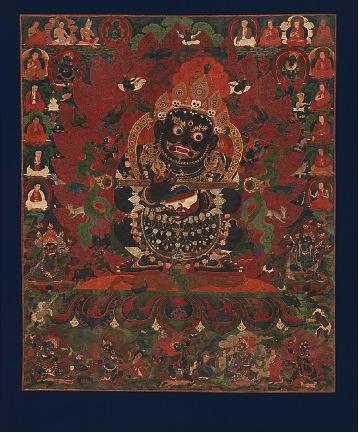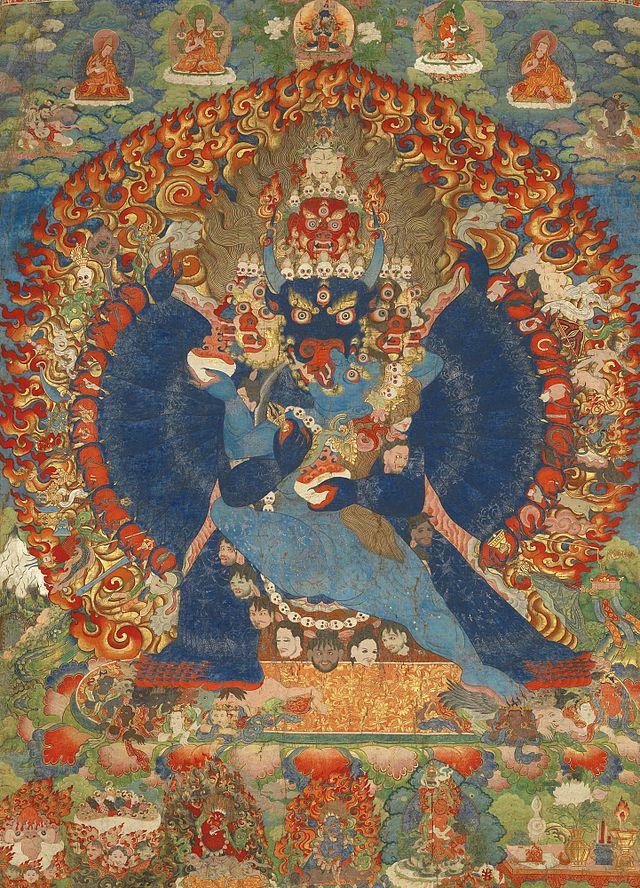Tibetan Vajrayana imagery, for the most part, illustrates fantastical literary texts by reflecting metaphor and symbolism. Notions of aesthetic achievement and the sense of beauty within this tradition rest on complex foundations tied to the religious phenomena expressed in the artworks. Practically every object, from the highest to the humblest, reflects religious thought and contains symbolism that is often bewilderingly abstruse.
During the time I spent working in museums and galleries, I came to realize the difficulties of deciphering meaning in religious works of art, in particular for those who have no knowledge of the relevant tradition. What, for example, would one make of a highly iconographical work such as Millais’s Christ in the House of His Parents with no knowledge of Christianity or its iconography? Much of its spiritual affective power would be lost.
One of the most common difficulties or misconceptions relating to Vajrayana imagery seemed to occur when people encountered the wrathful forms of enlightened beings for the first time. For example, I was working in a museum that had recently acquired an imposing image of the wrathful deity Mahakala. The piece attracted a lot of attention from staff as well as the public due to its heavy physical presence and exquisite detail, but particularly on account of Mahakala’s captivating, wild-eyed countenance and gruesome paraphernalia. After talking with visitors, it became clear that many were misinterpreting the image as a vision of brute destruction, a force to be feared. But Mahakala is in fact a fierce emanation of the bodhisattva Avalokiteshvara, and is especially revered in his role as a compassionate protector.
The confusion arose from Mahakala’s fierce appearance, with his inky, midnight coloring, curling beard, and fiery eyebrows. In the aforementioned image, he is depicted wearing a Brahmin cord of a live green snake coiled around his bulging belly. Beneath it rests a grisly garland of wonderfully individualized severed heads, strung by the topknots in their hair. As a fierce manifestation of Avalokiteshvara, Mahakala takes on such a fearsome form in order to conquer all emotional afflictions and to dispel spiritual obstacles for all sentient beings. These hindrances are embodied in the myriad dreadful creatures that surround Mahakala in the thangka.
In one hand he grasps a vajra-handled chopper, a blade symbolic of the wisdom of the Vajrayana vehicle and a common implement of wrathful deities. In his other hand rests an upturned skull-cup (Skt. kapala), in which he grinds all negativities. These consist of the afflictions that cloud the mind; the five “poisons,” or ignorance, attachment, anger, pride, and jealousy; and all other delusions. These impurities are symbolized by the blood and liquefied brains of demons, which fill the cup. The imagery reflects the actual use of the skull-cup in tantric ritual as an alembic for the transmutation of obstructions to enlightenment into the elixir of immortality (Skt. amrita) (“immortality” in the Tibetan Vajrayana tradition being understood as non-duality rather than corporeal deathlessness), wisdom, and compassion. It is one of the most profound ritual objects and symbols within Vajrayana iconography, and is imbued with extensive levels of meaning. Simply put, it is a metaphor for Mahakala’s true, enlightened nature as the ultimate embodiment of compassion, one of the core principles in Buddhism.
This lyrical and symbolic (rather than realistic) approach reflects the complex network of semiotic, doctrinal, and mythological associations in Vajrayana iconography. An understanding of the sophisticated imagery and metaphors contained within Tibetan art is crucial if we wish to appreciate its theological concepts.
At times, the problem viewers faced was not that they did not understand the dense religious iconography and symbolism in the paintings, but that they could not even clearly identify the imagery. I only realized this after I had given a talk on a depiction of a multi-limbed, multi-headed Vajrabhairava in sexual union (T. yab-yum), when a colleague from another department told me how many times she had walked past the work without being able to make out the deities’ interlocking forms. Once she was able to do so, the layers of meaning gradually unfolded before her as she spent more time contemplating the piece, and through further guidance, learned more about it. The depiction of deities in sexual union, or “father-mother” embrace, represents another central concept within Tibetan Buddhism: the non-dual nature of ultimate reality. It was only by identifying the figures and the concepts they represent that she was able to appreciate the mastery of the work’s dense but coherent design of spiritual clarity and rhythmic force.
The way in which we display objects can also drastically alter our understanding of them. An example of this is the way we so often see traditional Tibetan thangka paintings displayed, removed from their original cloth backings and inserted into modern frames to appeal to a Western aesthetic sensibility. This deliberate alteration of an artwork, usually without indication on the labeling, could be seen to deprive the viewer of an authentic experience that includes a sense of place, history, and usage.Furthermore, the current trend toward whitewashed galleries and increasingly spare supplemental information and labeling only exacerbates the issue and confuses many viewers who may need further guidance. Something as simple as providing photos of how a thangka is displayed in a monastery—usually alongside a panoply of ritual items—could help the viewer in understanding the thangka’s place within the religious and ritualistic context for which it was originally intended. Whilst focusing on aestheticism, “art for art’s sake,” aesthetic distance, or formalism can be instructive and worthwhile endeavors, when taken in isolation these approaches tend to overlook the larger and often central meaning of a piece, which can potentially be of so much benefit to viewers.








